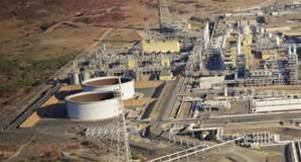Australian gas miner Woodside is using data from 200,000 sensors at its Pluto liquefied natural gas facility to identify signs of "foaming" and prevent these catastrophic events from happening.

Woodside's $10 billion Pluto LNG facility came equipped with 200,000 sensors, the company's head of strategy, science and technology Shaun Gregory told the AWS Summit today.
The sensors were being used to measure temperature and pressure under the plant's original design purpose, Gregory said, and Woodside wanted to find additional uses for the generated data.
The potential offered by the sensors became starkly clear the following year when Woodside was hit with an event that threatened to shut down the entire facility.
The problem lay in how the plant strips acid gas from carbon stream before liquefaction within the acid gas removal unit (AGRU).
"Foaming" can build up inside the AGRU like gas within a shaken beer bottle, but Woodside's engineers were unable to tell when such foaming occurs.
"If you pour a beer really quick it foams over the glass, that's bad news. It's really bad news in a gas plant like that," Gregory said.
"[And] we can't see it. It's enclosed in big towers. So we went about analysing a small number of sensors, in this instance around 10,000 sensors, to see if we can detect foaming."
The effort was Woodside's first prototype of using the big data generated by the Pluto sensors.
Over a six-week period, it connected the sensors into AWS' cloud and used the cloud provider's big data technologies coupled with third-party analytics platforms like IBM's Watson to make use of the mass amounts of data.
"We brought 30 years of operating experience and all those sensors and data to come up with not only detection but a two-hour and a 72-hour and up to a one week forecast of when foaming might occur," Gregory said.
"So we got not just the data collection and analysis, we got insight as to when an incident was coming and we could take action to keep that plant running."
The prototype completed at the end of 2014, and its success led Woodside to last year activate all 200,000 sensors into the public cloud last year.
"We got a call from Amazon: 'what are you doing? There's a big spike in your data, would you like some help?'" Gregory said.
The sensors now stream into 6000 analytics models and over 3 million calculations for Pluto per day, Gregory said, involving everything from monitoring a valve to detect whether it's likely to fail within the next month, to protecting the AGRU from foaming.
This year the gas miner will expand its sensor-based big data efforts to the remaining 75 percent of its onshore and offshore operations, and plans to eventually have such capabilities throughout its entire business.
Woodside spoke at the 2016 AWS Summit, which runs from April 27-28 at the Horden Pavilion in Sydney. iTnews is an exclusive media partner of the event.

.png&h=140&w=231&c=1&s=0)
.png&h=140&w=231&c=1&s=0)



_page-0001.jpg&w=100&c=1&s=0)


 Integrate Expo 2025
Integrate Expo 2025
.png&w=120&c=1&s=0) Security Exhibition & Conference 2025
Security Exhibition & Conference 2025
 Digital Leadership Day Queensland
Digital Leadership Day Queensland
 Government Cyber Security Showcase Queensland
Government Cyber Security Showcase Queensland
 Government Innovation Showcase Queensland
Government Innovation Showcase Queensland











.jpg&h=140&w=231&c=1&s=0)



